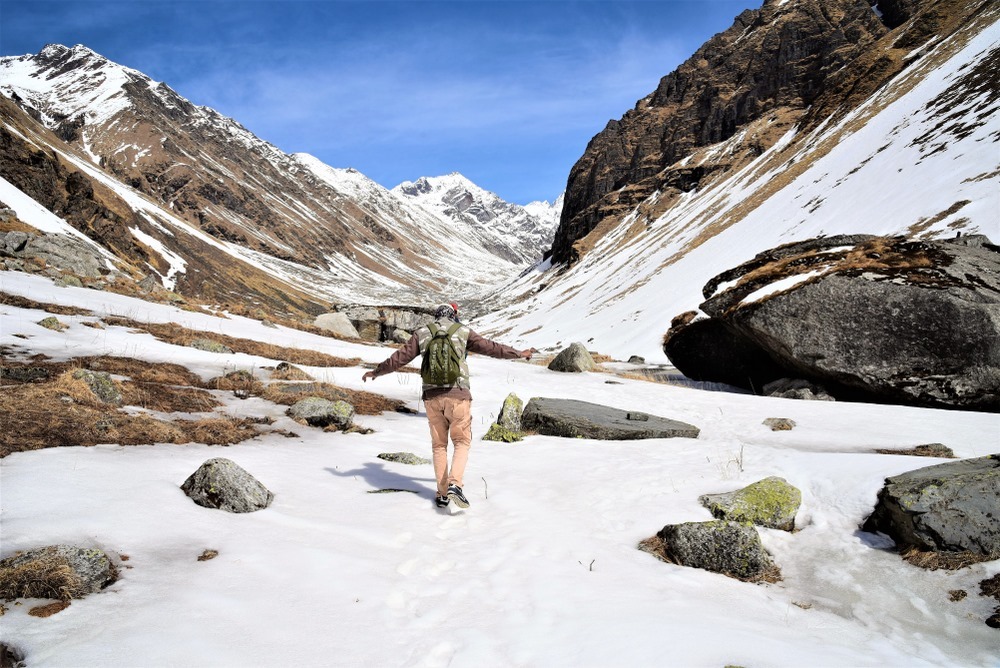I’ve always believed that trekking is less about the kilometers you cover and more about the stories you collect along the way. That said, before stepping into the mountains, every trekker has one burning question: How far is the walk? If you’re considering the Har Ki Doon trek, let me break down the distance for you in a straightforward way.
The Starting Point: Sankri Village
Sankri, a little yet energetic town in Uttarkashi, Uttarakhand, is where every Har Ki Doon trek starts. To reach Sankri, I had to take an overnight drive from Dehradun, which is around 200 km. But the actual trekking starts only after Sankri. This is the point where the real adventure begins, where jeeps stop and boots take over.
Total Distance of the Trek
The overall distance of the Har Ki Doon hike is roughly 45–47 kilometres (round trip).
-
One way, you’ll walk roughly 22–24 km from Sankri to Har Ki Doon valley.
-
The distance doubles because you take the same path back.
Now, this isn’t a single-day walk. The trek is spread out across 6 to 7 days, which makes it manageable even for beginners. On most days, you’ll walk between 8–10 km, taking anywhere between 5–7 hours, depending on your pace and breaks.
Breakdown of Trekking Days and Distances
Here’s how the trek usually unfolds:
-
Day 1 (Sankri to Taluka by jeep + Taluka to Seema/Osla trek)
Drive 12 km to Taluka, then trek about 12 km to Seema or Osla. This day feels long, but the trail is mostly gradual, following the river. -
Day 2 (Seema/Osla to Har Ki Doon)
Around 10–12 km trek. This is where the valley opens up, and you start feeling why it’s called the “Valley of Gods.” -
Day 3 (Exploration/Rest at Har Ki Doon)
Most groups stay an extra day here to explore nearby spots like Jaundhar Glacier or Maninda Tal. Expect an additional 5–6 km hike, but without heavy backpacks. -
Day 4 & 5 (Return journey)
The descent usually takes two days, retracing your steps back to Seema/Osla and then Taluka. -
Day 6 (Taluka to Sankri drive)
Just a short jeep ride back.
So, in total, by the end of the trek, your legs would have carried you about 45–47 km.
Is the Distance Manageable for Beginners?
I won’t sugarcoat it: walking nearly 50 km in a week sounds intimidating on paper. But once you’re on the trail, the pace is steady, and the route gives you enough time to adapt. Unlike treks where you climb steeply every day, Har Ki Doon is more of a gradual ascent, which makes the distance less punishing.
When I did it, I noticed a lot of first-time trekkers who managed comfortably. The key is to prepare a bit in advance—regular walks, jogging, or light workouts a few weeks before you go can make the trek enjoyable rather than exhausting.
The Beauty That Distracts You From the Distance
Here’s the truth: you’ll hardly notice how far you’ve walked because the valley constantly distracts you. The trail passes through dense forests of pine and rhododendron, wooden bridges over streams, and remote villages that feel stuck in time.
By the time you reach Har Ki Doon, the distance covered feels like a reward. The valley opens up to meadows with snow-capped peaks like Swargarohini and Black Peak towering above. It’s the kind of view that makes the last 20 km feel worth every step.
Guided Trek Experience
Now, about doing the trek—I would highly recommend going with a guided group unless you’re an extremely experienced trekker used to the Himalayan routes. The trails, though marked, can get confusing at some stretches, and having local guides not only makes navigation easier but also adds to the experience with stories of the villages and mountains.
When I planned my har ki doon trek, I joined The Searching Souls, a well-known trekking organization. They’re not just about taking you from point A to B—they focus on making the trek safe, sustainable, and enjoyable. What I personally liked was how they managed camps, meals, and acclimatization. It let me focus on enjoying the trail instead of worrying about logistics.
You don’t feel like you’re on a “tour”; it feels like you’re walking with a group of people who love the mountains as much as you do. That’s what made the 45 km walk not just manageable but memorable.
Final Thoughts on the Distance
So, to answer the original question—yes, the Har Ki Doon trek is about 45–47 km of walking, spread over nearly a week. It’s not the easiest stroll, but it’s also far from impossible. With the gradual ascent, regular breaks, and mesmerizing views, the distance feels less like a challenge and more like part of the adventure.
If you’re someone who has always dreamt of trekking in the Himalayas but worried about how far you can walk, Har Ki Doon is the perfect start. Trust me, by the end of it, you’ll wish the walk was a little longer.
FAQs About Har Ki Doon Trek Distance
1. How many hours do we walk each day?
On average, about 5–7 hours per day, covering 8–12 km.
2. Is 45 km too much for a beginner?
Not really. Since the trek is spread across 6–7 days, it’s manageable even for first-timers with basic fitness.
3. Do we have to carry all our luggage?
If you go with an organization like The Searching Souls, they provide options for offloading your backpack if needed, so you only carry essentials.
4. What’s harder—the ascent or descent?
The ascent is gradual and not too steep, but the descent can feel tough on the knees. Trekking poles help a lot.
5. Can the distance vary depending on the route?
Yes, slightly. Some groups camp at Osla, while others at Seema, and exploration days at Har Ki Doon can add extra kilometers.

